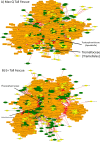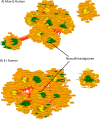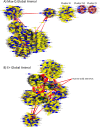Integrative interactomics applied to bovine fescue toxicosis
- PMID: 35318361
- PMCID: PMC8941056
- DOI: 10.1038/s41598-022-08540-2
Integrative interactomics applied to bovine fescue toxicosis
Abstract
Bovine fescue toxicosis (FT) is caused by grazing ergot alkaloid-producing endophyte (Epichloë coenophiala)-infected tall fescue. Endophyte's effects on the animal's microbiota and metabolism were investigated recently, but its effects in planta or on the plant-animal interactions have not been considered. We examined multi-compartment microbiota-metabolome perturbations using multi-'omics (16S and ITS2 sequencing, plus untargeted metabolomics) in Angus steers grazing non-toxic (Max-Q) or toxic (E+) tall fescue for 28 days and in E+ plants. E+ altered the plant/animal microbiota, decreasing most ruminal fungi, with mixed effects on rumen bacteria and fecal microbiota. Metabolic perturbations occurred in all matrices, with some plant-animal overlap (e.g., Vitamin B6 metabolism). Integrative interactomics revealed unique E+ network constituents. Only E+ had ruminal solids OTUs within the network and fecal fungal OTUs in E+ had unique taxa (e.g., Anaeromyces). Three E+-unique urinary metabolites that could be potential biomarkers of FT and targeted therapeutically were identified.
© 2022. The Author(s).
Conflict of interest statement
The authors declare no competing interests.
Figures









References
-
- Thompson FN, Stuedemann JA. Pathophysiology of fescue toxicosis. Agr. Ecosyst. Environ. 1993;44:263–281. doi: 10.1016/0167-8809(93)90050-y. - DOI
Publication types
MeSH terms
Substances
LinkOut - more resources
Full Text Sources

